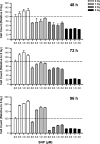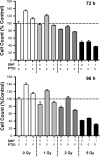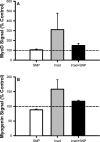Satellite cells say NO to radiation
- PMID: 21319985
- PMCID: PMC4049230
- DOI: 10.1667/RR2453.1
Satellite cells say NO to radiation
Abstract
Skeletal muscles are commonly exposed to radiation for diagnostic procedures and the treatment of cancers and heterotopic bone formation. Few studies have considered the impact of clinical doses of radiation on the ability of satellite cells (myogenic stem cells) to proliferate, differentiate and contribute to recovering/maintaining muscle mass. The primary objective of this study was to determine whether the proliferation of irradiated satellite cells could be rescued by manipulating NO levels via pharmacological approaches and mechanical stretch (which is known to increase NO levels). We used both SNP (NO donor) and PTIO (NO scavenger) to manipulate NO levels in satellite cells. We observed that SNP was highly effective in rescuing the proliferation of irradiated satellite cells, especially at doses less than 5 Gy. The potential importance of NO was further illustrated by the effects of PTIO, which completely inhibited the rescue effect of SNP. Mechanical cyclic stretch was found to produce significant increases in NO levels of irradiated satellite cells, and this was associated with a robust increase in satellite cell proliferation. The effects of both radiation and NO on two key myogenic regulatory factors (MyoD and myogenin) were also explored. Irradiation of satellite cells produced a significant increase in both MyoD and myogenin, effects that were mitigated by manipulating NO levels via SNP. Given the central role of myogenic regulatory factors in the proliferation and differentiation of satellite cells, the findings of the current study underscore the need to more fully understand the relationship between radiation, NO and the functionality of satellite cells.
Figures





Similar articles
-
The radiosensitivity of satellite cells: cell cycle regulation, apoptosis and oxidative stress.Radiat Res. 2010 Nov;174(5):582-9. doi: 10.1667/RR2190.1. Epub 2010 Aug 2. Radiat Res. 2010. PMID: 20726709 Free PMC article.
-
Changes in proliferation, differentiation, fibroblast growth factor 2 responsiveness and expression of syndecan-4 and glypican-1 with turkey satellite cell age.Dev Growth Differ. 2013 Jun;55(5):622-34. doi: 10.1111/dgd.12069. Dev Growth Differ. 2013. PMID: 23772770
-
Heparan sulfate proteoglycans, syndecan-4 and glypican-1, differentially regulate myogenic regulatory transcription factors and paired box 7 expression during turkey satellite cell myogenesis: implications for muscle growth.Poult Sci. 2012 Jan;91(1):201-7. doi: 10.3382/ps.2011-01695. Poult Sci. 2012. PMID: 22184445
-
Function of the myogenic regulatory factors Myf5, MyoD, Myogenin and MRF4 in skeletal muscle, satellite cells and regenerative myogenesis.Semin Cell Dev Biol. 2017 Dec;72:19-32. doi: 10.1016/j.semcdb.2017.11.011. Epub 2017 Nov 15. Semin Cell Dev Biol. 2017. PMID: 29127046 Review.
-
Skeletal muscle hypertrophy and regeneration: interplay between the myogenic regulatory factors (MRFs) and insulin-like growth factors (IGFs) pathways.Cell Mol Life Sci. 2013 Nov;70(21):4117-30. doi: 10.1007/s00018-013-1330-4. Epub 2013 Apr 4. Cell Mol Life Sci. 2013. PMID: 23552962 Free PMC article. Review.
Cited by
-
Cryopreserved Stem Cells Incur Damages Due To Terrestrial Cosmic Rays Impairing Their Integrity Upon Long-Term Storage.Cell Transplant. 2022 Jan-Dec;31:9636897211070239. doi: 10.1177/09636897211070239. Cell Transplant. 2022. PMID: 35170351 Free PMC article.
-
The effect of radiation dose on mouse skeletal muscle remodeling.Radiol Oncol. 2014 Jul 10;48(3):247-56. doi: 10.2478/raon-2014-0025. eCollection 2014 Sep. Radiol Oncol. 2014. PMID: 25177239 Free PMC article.
-
Whole-genome gene expression profiling reveals the major role of nitric oxide in mediating the cellular transcriptional response to ionizing radiation in normal human fibroblasts.Genomics. 2012 Nov;100(5):277-81. doi: 10.1016/j.ygeno.2012.07.007. Epub 2012 Jul 17. Genomics. 2012. PMID: 22814268 Free PMC article.
-
Divergent modification of low-dose ⁵⁶Fe-particle and proton radiation on skeletal muscle.Radiat Res. 2013 Nov;180(5):455-64. doi: 10.1667/RR3329.1. Epub 2013 Oct 17. Radiat Res. 2013. PMID: 24131063 Free PMC article.
-
Effect of irradiation on Akt signaling in atrophying skeletal muscle.J Appl Physiol (1985). 2016 Oct 1;121(4):917-924. doi: 10.1152/japplphysiol.00218.2016. Epub 2016 Aug 25. J Appl Physiol (1985). 2016. PMID: 27562841 Free PMC article.
References
-
- Rosenblatt JD, Parry DJ. Gamma irradiation prevents compensatory hypertrophy of overloaded mouse extensor digitorum longus muscle. J. Appl. Physiol. 1992;73:2538–2543. - PubMed
-
- Rosenblatt JD, Parry DJ. Adaptation of rat extensor digitorum longus muscle to gamma irradiation and overload. Pflugers Arch. 1993;423:255–264. - PubMed
-
- Rosenblatt JD, Yong D, Parry DJ. Satellite cell activity is required for hypertrophy of overloaded adult rat muscle. Muscle Nerve. 1994;17:608–613. - PubMed
Publication types
MeSH terms
Substances
Grants and funding
LinkOut - more resources
Full Text Sources

